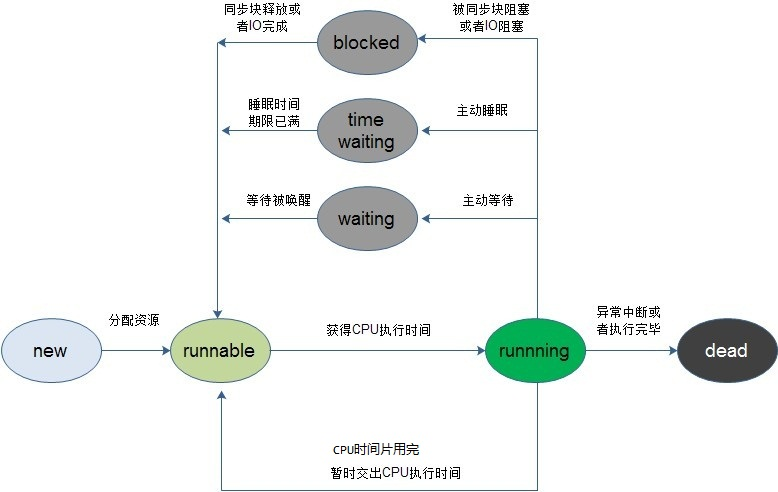在前面2篇文章分别讲到了线程和进程的由来、以及如何在Java中怎么创建线程和进程。今天我们来学习一下Thread类,在学习Thread类之前,先介绍与线程相关知识:线程的几种状态、上下文切换,然后接着介绍Thread类中的方法的具体使用。
以下是本文的目录大纲:
一.线程的状态
二.上下文切换
三.Thread类中的方法
若有不正之处,请多多谅解并欢迎批评指正。
请尊重作者劳动成果,转载请标明原文链接:
http://www.cnblogs.com/dolphin0520/p/3920357.html
一.线程的状态
在正式学习Thread类中的具体方法之前,我们先来了解一下线程有哪些状态,这个将会有助于后面对Thread类中的方法的理解。
线程从创建到最终的消亡,要经历若干个状态。一般来说,线程包括以下这几个状态:创建(new)、就绪(runnable)、运行(running)、阻塞(blocked)、time waiting、waiting、消亡(dead)。
当需要新起一个线程来执行某个子任务时,就创建了一个线程。但是线程创建之后,不会立即进入就绪状态,因为线程的运行需要一些条件(比如内存资源,在前面的JVM内存区域划分一篇博文中知道程序计数器、Java栈、本地方法栈都是线程私有的,所以需要为线程分配一定的内存空间),只有线程运行需要的所有条件满足了,才进入就绪状态。
当线程进入就绪状态后,不代表立刻就能获取CPU执行时间,也许此时CPU正在执行其他的事情,因此它要等待。当得到CPU执行时间之后,线程便真正进入运行状态。
线程在运行状态过程中,可能有多个原因导致当前线程不继续运行下去,比如用户主动让线程睡眠(睡眠一定的时间之后再重新执行)、用户主动让线程等待,或者被同步块给阻塞,此时就对应着多个状态:time waiting(睡眠或等待一定的事件)、waiting(等待被唤醒)、blocked(阻塞)。
当由于突然中断或者子任务执行完毕,线程就会被消亡。
下面这副图描述了线程从创建到消亡之间的状态:

在有些教程上将blocked、waiting、time waiting统称为阻塞状态,这个也是可以的,只不过这里我想将线程的状态和Java中的方法调用联系起来,所以将waiting和time waiting两个状态分离出来。
二.上下文切换
对于单核CPU来说(对于多核CPU,此处就理解为一个核),CPU在一个时刻只能运行一个线程,当在运行一个线程的过程中转去运行另外一个线程,这个叫做线程上下文切换(对于进程也是类似)。
由于可能当前线程的任务并没有执行完毕,所以在切换时需要保存线程的运行状态,以便下次重新切换回来时能够继续切换之前的状态运行。举个简单的例子:比如一个线程A正在读取一个文件的内容,正读到文件的一半,此时需要暂停线程A,转去执行线程B,当再次切换回来执行线程A的时候,我们不希望线程A又从文件的开头来读取。
因此需要记录线程A的运行状态,那么会记录哪些数据呢?因为下次恢复时需要知道在这之前当前线程已经执行到哪条指令了,所以需要记录程序计数器的值,另外比如说线程正在进行某个计算的时候被挂起了,那么下次继续执行的时候需要知道之前挂起时变量的值时多少,因此需要记录CPU寄存器的状态。所以一般来说,线程上下文切换过程中会记录程序计数器、CPU寄存器状态等数据。
说简单点的:对于线程的上下文切换实际上就是 存储和恢复CPU状态的过程,它使得线程执行能够从中断点恢复执行。
虽然多线程可以使得任务执行的效率得到提升,但是由于在线程切换时同样会带来一定的开销代价,并且多个线程会导致系统资源占用的增加,所以在进行多线程编程时要注意这些因素。
三.Thread类中的方法
通过查看java.lang.Thread类的源码可知:
public class Thread implements Runnable { /* Make sure registerNatives is the first thing <clinit> does. */ private static native void registerNatives(); static { registerNatives(); } private volatile char name[]; private int priority; private Thread threadQ; private long eetop; /* Whether or not to single_step this thread. */ private boolean single_step; /* Whether or not the thread is a daemon thread. */ private boolean daemon = false; /* JVM state */ private boolean stillborn = false; /* What will be run. */ private Runnable target; /* The group of this thread */ private ThreadGroup group; /* The context ClassLoader for this thread */ private ClassLoader contextClassLoader; /* The inherited AccessControlContext of this thread */ private AccessControlContext inheritedAccessControlContext;
Thread类实现了Runnable接口,在Thread类中,有一些比较关键的属性,比如name是表示Thread的名字,可以通过Thread类的构造器中的参数来指定线程名字,priority表示线程的优先级(最大值为10,最小值为1,默认值为5),daemon表示线程是否是守护线程,target表示要执行的任务。
下面是Thread类中常用的方法:
以下是关系到线程运行状态的几个方法:
1)start方法
start()用来启动一个线程,当调用start方法后,系统才会开启一个新的线程来执行用户定义的子任务,在这个过程中,会为相应的线程分配需要的资源。
2)run方法
run()方法是不需要用户来调用的,当通过start方法启动一个线程之后,当线程获得了CPU执行时间,便进入run方法体去执行具体的任务。注意,继承Thread类必须重写run方法,在run方法中定义具体要执行的任务。
3)sleep方法
sleep方法有两个重载版本:
sleep(long millis) //参数为毫秒 sleep(long millis,int nanoseconds) //第一参数为毫秒,第二个参数为纳秒
sleep相当于让线程睡眠,交出CPU,让CPU去执行其他的任务。
但是有一点要非常注意,sleep方法不会释放锁,也就是说如果当前线程持有对某个对象的锁,则即使调用sleep方法,其他线程也无法访问这个对象。看下面这个例子就清楚了:
public class Test { private int i = 10; private Object object = new Object(); public static void main(String[] args) throws IOException { Test test = new Test(); MyThread thread1 = test.new MyThread(); MyThread thread2 = test.new MyThread(); thread1.start(); thread2.start(); } class MyThread extends Thread{ @Override public void run() { synchronized (object) { i++; System.out.println("i:"+i); try { System.out.println("线程"+Thread.currentThread().getName()+"进入睡眠状态"); Thread.currentThread().sleep(10000); } catch (InterruptedException e) { // TODO: handle exception } System.out.println("线程"+Thread.currentThread().getName()+"睡眠结束"); i++; System.out.println("i:"+i); } } } }
输出结果:

从上面输出结果可以看出,当Thread-0进入睡眠状态之后,Thread-1并没有去执行具体的任务。只有当Thread-0执行完之后,此时Thread-0释放了对象锁,Thread-1才开始执行。
注意,如果调用了sleep方法,必须捕获InterruptedException异常或者将该异常向上层抛出。当线程睡眠时间满后,不一定会立即得到执行,因为此时可能CPU正在执行其他的任务。所以说调用sleep方法相当于让线程进入阻塞状态。
4)yield方法
调用yield方法会让当前线程交出CPU权限,让CPU去执行其他的线程。它跟sleep方法类似,同样不会释放锁。但是yield不能控制具体的交出CPU的时间,另外,yield方法只能让拥有相同优先级的线程有获取CPU执行时间的机会。
注意,调用yield方法并不会让线程进入阻塞状态,而是让线程重回就绪状态,它只需要等待重新获取CPU执行时间,这一点是和sleep方法不一样的。
5)join方法
join方法有三个重载版本:
join() join(long millis) //参数为毫秒 join(long millis,int nanoseconds) //第一参数为毫秒,第二个参数为纳秒
假如在main线程中,调用thread.join方法,则main方法会等待thread线程执行完毕或者等待一定的时间。如果调用的是无参join方法,则等待thread执行完毕,如果调用的是指定了时间参数的join方法,则等待一定的事件。
public class Test { public static void main(String[] args) throws IOException { System.out.println("进入线程"+Thread.currentThread().getName()); Test test = new Test(); MyThread thread1 = test.new MyThread(); thread1.start(); try { System.out.println("线程"+Thread.currentThread().getName()+"等待"); thread1.join(); System.out.println("线程"+Thread.currentThread().getName()+"继续执行"); } catch (InterruptedException e) { // TODO Auto-generated catch block e.printStackTrace(); } } class MyThread extends Thread{ @Override public void run() { System.out.println("进入线程"+Thread.currentThread().getName()); try { Thread.currentThread().sleep(5000); } catch (InterruptedException e) { // TODO: handle exception } System.out.println("线程"+Thread.currentThread().getName()+"执行完毕"); } } }
输出结果:

可以看出,当调用thread1.join()方法后,main线程会进入等待,然后等待thread1执行完之后再继续执行。
实际上调用join方法是调用了Object的wait方法,这个可以通过查看源码得知:
public final synchronized void join(long millis) throws InterruptedException { long base = System.currentTimeMillis(); long now = 0; if (millis < 0) { throw new IllegalArgumentException("timeout value is negative"); } if (millis == 0) { while (isAlive()) { wait(0); } } else { while (isAlive()) { long delay = millis - now; if (delay <= 0) { break; } wait(delay); now = System.currentTimeMillis() - base; } } }
wait方法会让线程进入阻塞状态,并且会释放线程占有的锁,并交出CPU执行权限。
由于wait方法会让线程释放对象锁,所以join方法同样会让线程释放对一个对象持有的锁。具体的wait方法使用在后面文章中给出。
6)interrupt方法
interrupt,顾名思义,即中断的意思。单独调用interrupt方法可以使得处于阻塞状态的线程抛出一个异常,也就说,它可以用来中断一个正处于阻塞状态的线程;另外,通过interrupt方法和isInterrupted()方法来停止正在运行的线程。
下面看一个例子:
public class Test { public static void main(String[] args) throws IOException { Test test = new Test(); MyThread thread = test.new MyThread(); thread.start(); try { Thread.currentThread().sleep(2000); } catch (InterruptedException e) { } thread.interrupt(); } class MyThread extends Thread{ @Override public void run() { try { System.out.println("进入睡眠状态"); Thread.currentThread().sleep(10000); System.out.println("睡眠完毕"); } catch (InterruptedException e) { System.out.println("得到中断异常"); } System.out.println("run方法执行完毕"); } } }
输出结果:

从这里可以看出,通过interrupt方法可以中断处于阻塞状态的线程。那么能不能中断处于非阻塞状态的线程呢?看下面这个例子:
public class Test { public static void main(String[] args) throws IOException { Test test = new Test(); MyThread thread = test.new MyThread(); thread.start(); try { Thread.currentThread().sleep(2000); } catch (InterruptedException e) { } thread.interrupt(); } class MyThread extends Thread{ @Override public void run() { int i = 0; while(i<Integer.MAX_VALUE){ System.out.println(i+" while循环"); i++; } } } }
运行该程序会发现,while循环会一直运行直到变量i的值超出Integer.MAX_VALUE。所以说直接调用interrupt方法不能中断正在运行中的线程。
但是如果配合isInterrupted()能够中断正在运行的线程,因为调用interrupt方法相当于将中断标志位置为true,那么可以通过调用isInterrupted()判断中断标志是否被置位来中断线程的执行。比如下面这段代码:
public class Test { public static void main(String[] args) throws IOException { Test test = new Test(); MyThread thread = test.new MyThread(); thread.start(); try { Thread.currentThread().sleep(2000); } catch (InterruptedException e) { } thread.interrupt(); } class MyThread extends Thread{ @Override public void run() { int i = 0; while(!isInterrupted() && i<Integer.MAX_VALUE){ System.out.println(i+" while循环"); i++; } } } }
运行会发现,打印若干个值之后,while循环就停止打印了。
但是一般情况下不建议通过这种方式来中断线程,一般会在MyThread类中增加一个属性 isStop来标志是否结束while循环,然后再在while循环中判断isStop的值。
class MyThread extends Thread{ private volatile boolean isStop = false; @Override public void run() { int i = 0; while(!isStop){ i++; } } public void setStop(boolean stop){ this.isStop = stop; } }
那么就可以在外面通过调用setStop方法来终止while循环。
7)stop方法
stop方法已经是一个废弃的方法,它是一个不安全的方法。因为调用stop方法会直接终止run方法的调用,并且会抛出一个ThreadDeath错误,如果线程持有某个对象锁的话,会完全释放锁,导致对象状态不一致。所以stop方法基本是不会被用到的。
8)destroy方法
destroy方法也是废弃的方法。基本不会被使用到。
以下是关系到线程属性的几个方法:
1)getId
用来得到线程ID
2)getName和setName
用来得到或者设置线程名称。
3)getPriority和setPriority
用来获取和设置线程优先级。
4)setDaemon和isDaemon
用来设置线程是否成为守护线程和判断线程是否是守护线程。
守护线程和用户线程的区别在于:守护线程依赖于创建它的线程,而用户线程则不依赖。举个简单的例子:如果在main线程中创建了一个守护线程,当main方法运行完毕之后,守护线程也会随着消亡。而用户线程则不会,用户线程会一直运行直到其运行完毕。在JVM中,像垃圾收集器线程就是守护线程。
Thread类有一个比较常用的静态方法currentThread()用来获取当前线程。
在上面已经说到了Thread类中的大部分方法,那么Thread类中的方法调用到底会引起线程状态发生怎样的变化呢?下面一幅图就是在上面的图上进行改进而来的:
